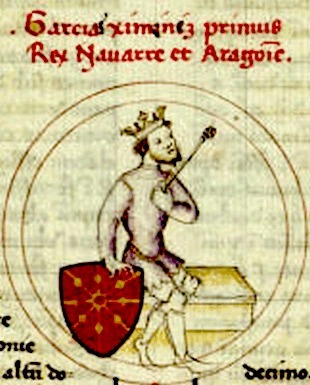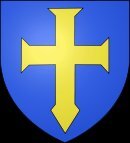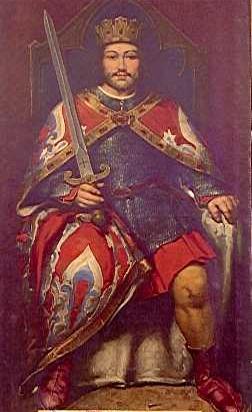maximum test » García III Sánchez de Navarra rey de Navarra (± 919-970)
Personal data García III Sánchez de Navarra rey de Navarra
- He was born about 919.
- He was christened in King, 925-970, age 6, 925.
- Profession: Roi, de Pampelune, de Navarre.
- He died on February 22, 970.
- He is buried in San EstebánSpain.
- A child of Sancho Garcés I García and Toda Aznárez de Larraún
- This information was last updated on January 22, 2019.
Household of García III Sánchez de Navarra rey de Navarra
![]() Attention: Wife (Andregoto Galíndez) is also his cousin.
Attention: Wife (Andregoto Galíndez) is also his cousin.
He is married to Andregoto Galíndez.
They got married in the year 934.
Child(ren):
The couple were divorced in 943.
Notes about García III Sánchez de Navarra rey de Navarra
#Générale##Générale#Naissance : vers 900 ou en 919
Profession : Roi de Navarre de 925 à 970.
{geni:about_me} https://en.wikipedia.org/wiki/Garc%C3%ADa_S%C3%A1nchez_I_of_Pamplona
http://www.biografiasyvidas.com/biografia/g/garcia_ii_sanchez_i_2.htm
http://www.friesian.com/perifran.htm#basque
García Sánchez I of Pamplona
From Wikipedia, the free encyclopedia
García Sánchez I, sometimes García I, II, III or IV (c. 919 – 970) was the king of Pamplona from 931 until his death in 970. He was the son of King Sancho I and Toda Aznárez. Being just six years old at the time of his father's death, his uncle Jimeno Gárces succeeded, and it was just in the last year of the latter's reign, in 930, that Garcia appears with the royal title, but this was probably just a courtesy. On Jimeno's death, 12-year old García succeeded, with his mother Toda serving as regent. This regency ended in 934, when his first cousin Caliph Abd-ar-Rahman III intervened on his behalf, and García began to rule as sole king.
With the support of his energetic and diplomatic mother, García, like his father, engaged in a number of conflicts with the Moors. He married his first cousin, Andregota Galíndez, daughter and coheiress of Galindo Aznárez II, Count of Aragón, having one son and heir, Sancho, before divorcing her. He then married Teresa, thought to be from León.
García was succeeded by his son Sancho II Garcés, nicknamed Abarca. He also created a novel kingdom centered at Viguera for his son by Teresa, Ramiro Garcés. By her he also had a daughter, Urraca, married firstly Fernán González of Castile and secondly William II Sánchez of Gascony.
--------------------
García Sánchez I, sometimes García I, II, III or IV (c. 919 – 970) was the king of Pamplona from 931 until his death in 970. He was the son of King Sancho I and Toda Aznárez. Being just six years old at the time of his father's death, his uncle Jimeno Gárces succeeded, and it was just in the last year of the latter's reign, in 930, that Garcia appears with the royal title, but this was probably just a courtesy. On Jimeno's death, 12-year old García succeeded, with his mother Toda serving as regent. This regency ended in 934, when his first cousin Caliph Abd-ar-Rahman III intervened on his behalf, and García began to rule as sole king.
With the support of his energetic and diplomatic mother, García, like his father, engaged in a number of conflicts with the Moors. He married his first cousin, Andregota Galíndez, daughter and coheiress of Galindo Aznárez II, Count of Aragón, having one son and heir, Sancho, before divorcing her. He then married Teresa, daughter of Ramiro II of León.
García was succeeded by his son Sancho II Garcés, nicknamed Abarca. He also created a novel kingdom centered at Viguera for his son by Teresa, Ramiro Garcés. By her he also had a daughter, Urraca, married firstly Fernán González of Castile and secondly William II Sánchez of Gascony.
--------------------
García Sánchez I, sometimes García I, II, III or IV (c. 919 – 970) was the king of Pamplona from 931 until his death in 970. He was the son of King Sancho I and Toda Aznárez. Being just six years old at the time of his father's death, his uncle Jimeno Gárces succeeded, and it was just in the last year of the latter's reign, in 930, that Garcia appears with the royal title, but this was probably just a courtesy. On Jimeno's death, 12-year old García succeeded, with his mother Toda serving as regent. This regency ended in 934, when his first cousin Caliph Abd-ar-Rahman III intervened on his behalf, and García began to rule as sole king.
With the support of his energetic and diplomatic mother, García, like his father, engaged in a number of conflicts with the Moors. He married his first cousin, Andregota Galíndez, daughter and coheiress of Galindo Aznárez II, Count of Aragón, having one son and heir, Sancho, before divorcing her. He then married Teresa, daughter of Ramiro II of León.
García was succeeded by his son Sancho II Garcés, nicknamed Abarca. He also created a novel kingdom centered at Viguera for his son by Teresa, Ramiro Garcés. By her he also had a daughter, Urraca, married firstly Fernán González of Castile and secondly William II Sánchez of Gascony.
--------------------
García Sánchez I, sometimes García I, II, III or IV (c. 919 – 970) was the king of Pamplona from 931 until his death in 970. He was the son of King Sancho I and Toda Aznárez. Being just six years old at the time of his father's death, his uncle Jimeno Gárces succeeded, and it was just in the last year of the latter's reign, in 930, that Garcia appears with the royal title, but this was probably just a courtesy. On Jimeno's death, 12-year-old García succeeded, with his mother Toda serving as regent. This regency ended in 934, when his first cousin Caliph Abd-ar-Rahman III intervened on his behalf, and García began to rule as sole king.
With the support of his energetic and diplomatic mother, García, like his father, engaged in a number of conflicts with the Moors. He married his first cousin, Andregota Galíndez, daughter and coheiress of Galindo Aznárez II, Count of Aragón, having one son and heir, Sancho, before divorcing her. He then married Teresa, daughter of Ramiro II of León.
García was succeeded by his son Sancho II Garcés, nicknamed Abarca. He also created a novel kingdom centered at Viguera for his eldest son by Teresa, Ramiro Garcés. By her he also had son Jimeno, and a daughter, Urraca, married firstly Fernán González of Castile and secondly William II Sánchez of Gascony.
--------------------
Garcia sanchez I de Pamplona
García Sánchez I, rey de Pamplona (925 - 970) y conde de Aragón (943-970). Hijo del rey de Pamplona, Sancho Garcés I y de la reina Toda, nieta del rey Fortún Garcés.
A la muerte de Sancho Garcés I, el 10 de diciembre de 925, le heredó su hijo García Sánchez, a los 6 años de edad, bajo la tutela de su tío Jimeno Garcés, cuya muerte provocó una crisis por el control de la tutoría. Gracias a la intervención de su madre la reina Toda y a la mediación de Abderramán III, la situación quedó controlada.
Aun después de ser García Sánchez mayor de edad, la intervención de la reina madre en los asuntos de Estado influyó para que Navarra alcanzase una posición clave para los reinos cristianos en los años venideros.
Tres hermanas de García Sánchez estuvieron casadas con reyes leoneses: Urraca con Ramiro II, Sancha con Ordoño II y Onneca con Alfonso IV. Por esta causa, los navarros intervinieron en las guerras civiles del Reino de León. Al morir Ramiro II, los navarros mediaron, ayudando la reina Toda a su nieto Sancho para ocupar el trono y, después, cuando Sancho es expulsado por su otro nieto Ordoño "el Malo", la reina madre intercede para que Abderramán ayude a su nieto Sancho a recuperar el trono.
En 939 participó en la coalición formada por Ramiro II de León, Fernán González y tropas asturianas y gallegas, que obtuvieron una gran victoria sobre las de Abderramán III en la batalla de Simancas.
En 953 da junto a su madre Toda al Monasterio de San Martín de Albelda (La Rioja) la villa Bagibel, situada en los montes de Cameros, primera vez que aparece escrita esta denominación geográfica.
En 961 tomó parte en las disputas entre el condado de Castilla y el Reino de León y apresó a Fernán González, conde de Castilla, pero se negó a entregarlo a los musulmanes.
En 963 formó una alianza cristiana contra Alhakén II y fue derrotado por los musulmanes.
Murió el 22 de febrero de 970 y fue sepultado en el pórtico de la pequeña iglesia de San Esteban, en el castillo de Monjardín.
Matrimonios y descendencia
Contrajo primer matrimonio con Andregoto Galíndez, hija del conde de Aragón Galindo Aznárez II y Sancha Garcés [1] . Heredera del condado aragonés, Andregoto fue repudiada por su marido en 942 y se retiró a sus tierras de Aybar donde falleció después de 971[2] . Esta unión matrimonial daría lugar a la posterior unión Aragón y Pamplona. De este primer matrimonio nacieron:
Sancho Garcés II "Abarca", Rey de Pamplona y Conde de Aragón.
Toda Garcés [3]
Urraca Garcés[4] , casada en primeras nupcias con Fernán González, Conde de Castilla, y en segundas con Guillermo I de Gascuña.
Casó en segundas nupcias, alrededor de 943, con Teresa Ramírez hija del rey Ramiro II de León y de Adosinda Gutiérrez, naciendo de este matrimonio:
Ramiro Garcés de Viguera, primer Rey de Viguera. Murió antes de 991[5] .
Jimeno Garcés, conde[6] .
--------------------
--------------------
Garcia Sánchez I ou Garcia I de Navarra ou García II de Navarre ou García Sánchez I de Pamplona ou ainda conhecido como Garcia III (I) Sanches de Navarra (919 - 22 de Fevereiro de 970) foi o 5º rei de Pamplona (925 - 970) e conde de Aragão (943-970).
Filho do rei de Pamplona, Sancho Garcés I e da rainha Toda, neta do rei Fortún Garcés. Após a morte do seu pai, a 10 de Dezembro de 925, herdou aos seis anos de idade, sob a tutela de seu tio Jimeno Garcés. Este último, ao morrer, provocou uma crise pelo controlo da tutoria. Graças à intervenção da sua mãe, a rainha Toda, e à mediação de Abderramão III, a situação ficou controlada.
--------------------
García Sánchez I (c. 9191 -22 de febrero de 970),2 rey de Pamplona desde 925 hasta su muerte. Hijo del rey de Pamplona, Sancho Garcés I y de la reina Toda,3 nieta del rey Fortún Garcés.
A la muerte de Sancho Garcés I, el 10 de diciembre de 925, le heredó su hijo García Sánchez, a los seis años de edad, bajo la tutela de su tío Jimeno Garcés, cuya muerte provocó una crisis por el control de la tutoría. Gracias a la intervención de su madre la reina Toda y a la mediación de Abderramán III, la situación quedó controlada.
Después de ser García Sánchez mayor de edad en 933, asumió la tutela de Andregoto Galíndez su prometida y por consiguiente el gobierno del condado de Aragón, hasta que el matrimonio fue anulado antes de 943, año en que aparece por primera vez con su segunda esposa, Teresa Ramírez.4
La intervención de la reina madre en los asuntos de gobierno influyó para que el Reino de Pamplona alcanzase una posición clave para los reinos cristianos en los años venideros. Tres hermanas de García Sánchez estuvieron casadas con reyes leoneses:3 Urraca con Ramiro II, Sancha con Ordoño II y Onneca con Alfonso IV. Por esta causa, los navarros intervinieron en las guerras civiles del Reino de León. Al morir Ramiro II, los navarros mediaron, ayudando la reina Toda a su nieto Sancho para ocupar el trono y, después, cuando Sancho es expulsado por su otro nieto Ordoño «el Malo», la reina madre intercede para que Abderramán ayude a su nieto Sancho a recuperar el trono.
En 939 participó en la coalición formada por Ramiro II de León, Fernán González y tropas asturianas y gallegas, que obtuvieron una gran victoria sobre las de Abderramán III en la batalla de Simancas.5
En 953 da junto a su madre Toda al Monasterio de San Martín de Albelda (La Rioja) la villa Bagibel, situada en los montes de Cameros, primera vez que aparece escrita esta denominación geográfica.
http://es.wikipedia.org/wiki/Garc%C3%ADa_Sánchez_I_de_Pamplona
--------------------
De Wikipedia:
A la muerte de Sancho Garcés I, el 10 de diciembre de 925, le heredó su hijo García Sánchez, a los seis años de edad, bajo la tutela de su tío Jimeno Garcés, cuya muerte provocó una crisis por el control de la tutoría. Gracias a la intervención de su madre la reina Toda y a la mediación de Abderramán III, la situación quedó controlada.
Después de ser García Sánchez mayor de edad en 933, asumió la tutela de Andregoto Galíndez su prometida y por consiguiente el gobierno del condado de Aragón, hasta que el matrimonio fue anulado antes de 943, año en que aparece por primera vez con su segunda esposa, Teresa Ramírez.
En 939 participó en la coalición formada por Ramiro II de León, Fernán González y tropas asturianas y gallegas, que obtuvieron una gran victoria sobre las de Abderramán III en la batalla de Simancas.
En 953 dona, junto a su madre Toda, al Monasterio de San Martín de Albelda (La Rioja), la villa Bagibel, situada en los montes de Cameros, primera vez que aparece escrita esta denominación geográfica.
En 961 tomó parte en las disputas entre el condado de Castilla y el Reino de León y apresó a Fernán González, conde de Castilla, pero se negó a entregarlo a los musulmanes. En 963 formó una alianza cristiana contra Alhakén II y fue derrotado por los musulmanes.
Murió el 22 de febrero de 970 y fue sepultado en el pórtico de la pequeña iglesia de San Esteban, en el castillo de Monjardín.
King de Navarre, Basque.
He assumed the crown about 900.
Timeline García III Sánchez de Navarra rey de Navarra
This functionality is only available in Javascript supporting browsers.
Click on the names for more info.
Symbols used:  grandparents
grandparents
 parents
parents
 brothers/sisters
brothers/sisters
 children
children
 grandparents
grandparents
 parents
parents
 brothers/sisters
brothers/sisters
 children
children
Ancestors (and descendant) of García III Sánchez de Navarra
García III Sánchez de Navarra  | ||||||||||||||||||||||||||||||||||
934 | ||||||||||||||||||||||||||||||||||
Andregoto Galíndez | ||||||||||||||||||||||||||||||||||
The data shown has no sources.
Matches in other publications
This person also appears in the publication:About the surname Sánchez de Navarra
- View the information that Genealogie Online has about the surname Sánchez de Navarra.
- Check the information Open Archives has about Sánchez de Navarra.
- Check the Wie (onder)zoekt wie? register to see who is (re)searching Sánchez de Navarra.
The maximum test publication was prepared by Ard van Bergen.
When copying data from this family tree, please include a reference to the origin:
Ard van Bergen, "maximum test", database, Genealogy Online (https://www.genealogieonline.nl/maximum-test/I6000000013042218251.php : accessed April 30, 2025), "García III Sánchez de Navarra rey de Navarra (± 919-970)".
Ard van Bergen, "maximum test", database, Genealogy Online (https://www.genealogieonline.nl/maximum-test/I6000000013042218251.php : accessed April 30, 2025), "García III Sánchez de Navarra rey de Navarra (± 919-970)".





